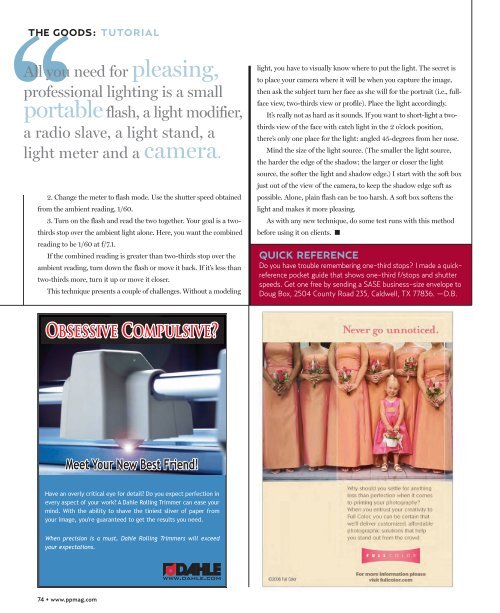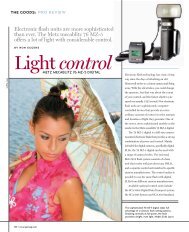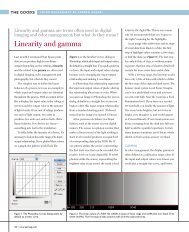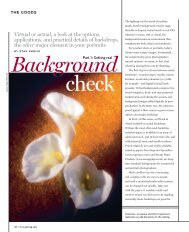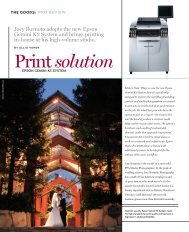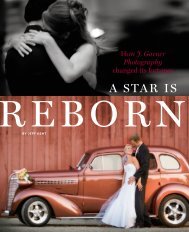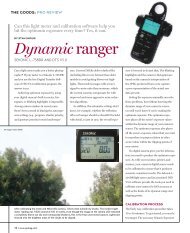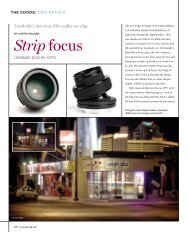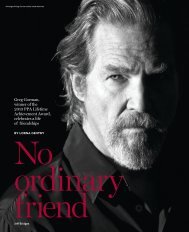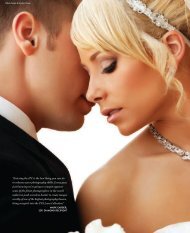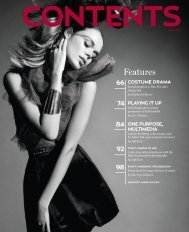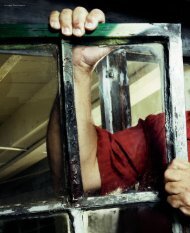january 2007 - Professional Photographer Magazine
january 2007 - Professional Photographer Magazine
january 2007 - Professional Photographer Magazine
You also want an ePaper? Increase the reach of your titles
YUMPU automatically turns print PDFs into web optimized ePapers that Google loves.
‘‘<br />
THE GOODS: TUTORIAL<br />
All you need for pleasing,<br />
professional lighting is a small<br />
portable flash, a light modifier,<br />
a radio slave, a light stand, a<br />
light meter and a camera.<br />
2. Change the meter to flash mode. Use the shutter speed obtained<br />
from the ambient reading, 1/60.<br />
3. Turn on the flash and read the two together. Your goal is a twothirds<br />
stop over the ambient light alone. Here, you want the combined<br />
reading to be 1/60 at f/7.1.<br />
If the combined reading is greater than two-thirds stop over the<br />
ambient reading, turn down the flash or move it back. If it’s less than<br />
two-thirds more, turn it up or move it closer.<br />
This technique presents a couple of challenges. Without a modeling<br />
Obsessive Compulsive?<br />
Meet Your New Best Friend!<br />
Have an overly critical eye for detail? Do you expect perfection in<br />
every aspect of your work? A Dahle Rolling Trimmer can ease your<br />
mind. With the ability to shave the tiniest sliver of paper from<br />
your image, you're guaranteed to get the results you need.<br />
When precision is a must, Dahle Rolling Trimmers will exceed<br />
your expectations.<br />
74 • www.ppmag.com<br />
www.dahle.com<br />
light, you have to visually know where to put the light. The secret is<br />
to place your camera where it will be when you capture the image,<br />
then ask the subject turn her face as she will for the portrait (i.e., fullface<br />
view, two-thirds view or profile). Place the light accordingly.<br />
It’s really not as hard as it sounds. If you want to short-light a twothirds<br />
view of the face with catch light in the 2 o’clock position,<br />
there’s only one place for the light: angled 45-degrees from her nose.<br />
Mind the size of the light source. (The smaller the light source,<br />
the harder the edge of the shadow; the larger or closer the light<br />
source, the softer the light and shadow edge.) I start with the soft box<br />
just out of the view of the camera, to keep the shadow edge soft as<br />
possible. Alone, plain flash can be too harsh. A soft box softens the<br />
light and makes it more pleasing.<br />
As with any new technique, do some test runs with this method<br />
before using it on clients. ■<br />
QUICK REFERENCE<br />
Do you have trouble remembering one-third stops? I made a quickreference<br />
pocket guide that shows one-third f/stops and shutter<br />
speeds. Get one free by sending a SASE business-size envelope to<br />
Doug Box, 2504 County Road 235, Caldwell, TX 77836. —D.B.


